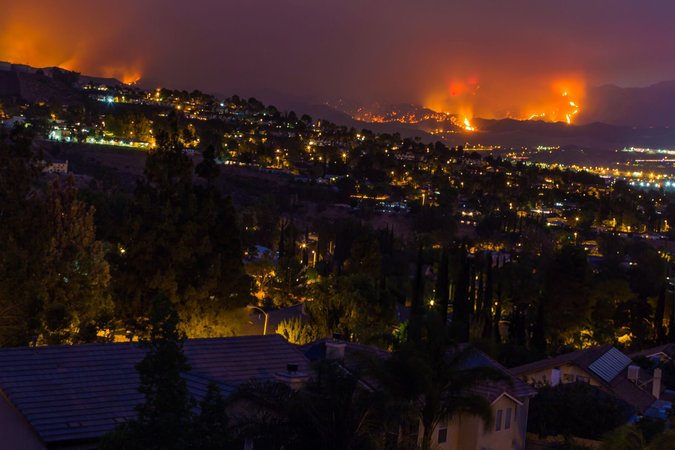As Climate Change Intensifies and Populations Grow, Southeastern Counties Are In the Hot Seat
💡 What’s the story?
With limited government resources, identifying where to spend time and money for federal climate-mitigation measures will be key in the coming years.
A new paper by researchers at Resources for the Future (RFF) and the USDA Forest Service highlights potential priorities: counties that have, or will have in the future, the unfortunate combination of high social vulnerability and large populations exposed to wildfire, water shortages, or heat stress.
The team found a “perfect storm” in the Southeastern United States—a blend of increasing climate risk, populous counties, and populations that have difficulty overcoming the impacts of natural disasters. The growth in wildfire risk here is particularly worrisome since most of the Southeast is privately owned, which makes federally led climate mitigation efforts difficult.
☀️ What are the key findings?
The researchers analyzed which counties will be most at risk of three natural disasters—water shortages, heat stress, and wildfire risk—over the coming decades. By modeling population growth and the changing distribution and strength of natural disasters, the team came to several conclusions.
- 31–65 percent of US counties that will face water shortages in 2070 have both large and vulnerable populations.
- 46–68 percent of counties that will face heat stress in 2070 have both large and vulnerable populations.
- Wildfire is a different story: only 5–19 percent of counties that will face significant wildfire risk in 2070 are both populous and vulnerable. Because there is not much overlap, wildfire managers will have to decide whether to make decisions based on efficiency (targeting areas with the largest exposed populations) or equity (targeting areas that cannot recover quickly).
The figure below shows the combined risks from all three analyzed natural disasters. Notably, risk factors compound: for example, droughts and heat waves can lead to increased fire risk.

📊 How do we know?
The new paper evaluates 50-year projections of natural hazards and population changes from the Forest Service’s 2020 Resources Planning Act Assessment. It also uses the Centers for Disease Control’s 2020 Social Vulnerability Index, which quantifies how people of different socioeconomic statuses and backgrounds are affected by natural disasters. By combining these well-established data sources, the researchers painted a new picture of where people will likely face high hazard risk in the future.
🏘️ What are the impacts of population growth?
Counties’ exposure to natural disasters is largely driven by a combination of population increase and accelerating climate change.
The new research shows that water shortages are likely to occur in the same general places that already experience them but intensify in some areas by 2070. Water-shortage risk notably increases in southwestern Texas, southern Louisiana, and large swaths of New Mexico and Arizona. Population growth accounts for 11–53 percent of increased exposure based on economic growth projections.
Wildfire hazard in 2070 is expected to grow in intensity and area compared to 2020. The most substantial change in fire pattern and magnitude is in the Southeastern United States, although areas of the southern Rockies and Front Range of Colorado may also experience greater risk. Between 11–55 percent of the increase in wildfire exposure is due to population growth.
By 2070, the geographic area affected by heat stress grows substantially compared to 2020. Population growth within heat-stressed areas grows, too, from 1 million people in the 2020 baseline to at least 6 million in 2070. Population growth accounts for 15–55 percent of increased exposure to heat stress. Like with fire hazard, the Southeast sees the greatest increase in risk.
Author Perspective
“Climate mitigation and adaptation requires immense amounts of resources and time. Knowing what places are most at risk, and how that risk may evolve over time, will help make sure that federal and state policymakers are prepared for the specific dangers that will likely affect vulnerable populations. This type of research is vital to make decisions that are efficient, effective, and help those in need.”
—David Wear, RFF nonresident senior fellow and director of RFF’s Land Use, Forestry, and Agriculture Program
📚 Where can I learn more?
For more, read the new paper by David Wear (RFF), Travis Warziniack (USFS), Claire O’Dea (USFS), and John Coulston (USFS) entitled “Changing Hazards, Exposure, and Vulnerability in the Conterminous United States, 2020-2070.”
Resources for the Future (RFF) is an independent, nonprofit research institution in Washington, DC. Its mission is to improve environmental, energy, and natural resource decisions through impartial economic research and policy engagement. RFF is committed to being the most widely trusted source of research insights and policy solutions leading to a healthy environment and a thriving economy.
Unless otherwise stated, the views expressed here are those of the individual authors and may differ from those of other RFF experts, its officers, or its directors. RFF does not take positions on specific legislative proposals.
For more information, please see our media resources page or contact Media Relations and Communications Manager Annie Tastet.




